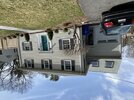I have a LR AWD Y on order, my first EV, and have an electrician lined up for a L2 charger installation run, but wondering your advice on where to tell him to terminate it/ hang the charger.
I’m leaning toward the left side of the exterior of the garage, so I could charge either parking spot, and if I really wanted to in the future I could flip the wires for the charger inside the garage.
The house has a tiny useless garage from the model T days with no room to get in and out of cars without dinging the doors, and no power currently so I expect we’ll still use it as a shed.
I was initially thinking just ask him to put a NEMA 14-50 on the right of the side door by the meter, but then realized stepping past the cord while charging with strollers and groceries etc would get old fast.
wondering those with EVs opinions/ advice.
edit: I should add this is in New England so -5F to 105F, snow, ice, heat waves etc
Also any disadvantages of going with a chargepoint flex at 40 amps off an outdoor rated nema 14-50? i can get $300 off a chargepoint or juicebox evse from my electric provider, so the extra 8 amps from a hardwired Tesla hpwc doesn’t seem worth it to me personally, unless I’m missing something. Plus I like the idea of having a universal plug vs proprietary


I’m leaning toward the left side of the exterior of the garage, so I could charge either parking spot, and if I really wanted to in the future I could flip the wires for the charger inside the garage.
The house has a tiny useless garage from the model T days with no room to get in and out of cars without dinging the doors, and no power currently so I expect we’ll still use it as a shed.
I was initially thinking just ask him to put a NEMA 14-50 on the right of the side door by the meter, but then realized stepping past the cord while charging with strollers and groceries etc would get old fast.
wondering those with EVs opinions/ advice.
edit: I should add this is in New England so -5F to 105F, snow, ice, heat waves etc
Also any disadvantages of going with a chargepoint flex at 40 amps off an outdoor rated nema 14-50? i can get $300 off a chargepoint or juicebox evse from my electric provider, so the extra 8 amps from a hardwired Tesla hpwc doesn’t seem worth it to me personally, unless I’m missing something. Plus I like the idea of having a universal plug vs proprietary
Attachments
Last edited:



